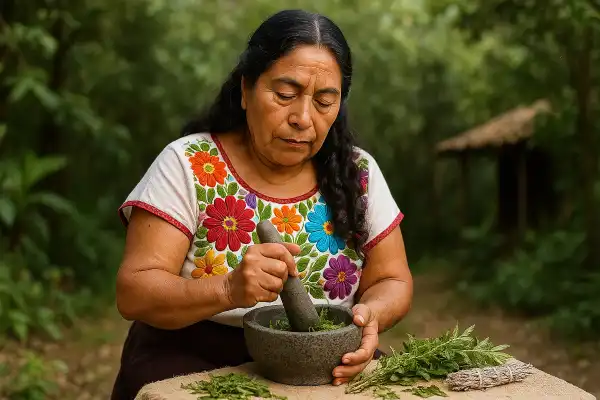Many individuals seeking holistic wellness approaches find themselves drawn to ancient healing systems that honor both body and spirit. Curanderismo traditional medicine represents one such path that has guided countless families toward balance for thousands of years. In a world where conventional medicine sometimes leaves gaps in addressing emotional and spiritual wellbeing, people naturally gravitate toward practices that view healing through a broader lens.
María del Pilar Fernández, a cultural anthropologist whose lineage traces through generations of curanderas in Oaxaca, believes that understanding curanderismo traditional medicine offers profound insight into humanity’s relationship with healing. Through her work at RainyBlue.org, she seeks to bridge ancient wisdom with contemporary wellness needs, honoring the sacred knowledge passed down through her ancestors while making these practices accessible to modern seekers.
Curanderismo traditional medicine
Curanderismo traditional medicine encompasses a comprehensive healing system that has been practiced for over 5,000 years, originating from indigenous Mesoamerican traditions and evolving through centuries of cultural exchange. At its core, curanderismo represents a holistic approach to wellness that integrates herbalism, spiritual healing, bodywork, and energy medicine to address imbalances in body, mind, and spirit.
The term “curanderismo” derives from the Spanish word “curar,” meaning “to heal,” though its roots extend far deeper than colonial terminology suggests. Archaeological evidence traces similar healing practices back to the Olmec civilization around 1,200 BCE, with the tradition surviving through the Aztec empire and adapting to incorporate Catholic elements during Spanish colonization. This synthesis created the rich tapestry of practices we recognize today, where indigenous plant knowledge meets European herbal traditions, and ancient rituals blend seamlessly with Christian prayers.

The philosophical foundation of curanderismo
Traditional Mexican medicine operates on eight fundamental philosophical premises that guide the understanding of disease, healing, and the patient-healer relationship. These principles recognize that illness often stems from emotional imbalances, environmental disharmony, spiritual disconnection, or exposure to malevolent forces. Unlike biomedical approaches that focus primarily on physical symptoms, curanderismo views each person as an interconnected whole where mental, emotional, and spiritual states directly influence physical health.
Curanderas and curanderos serve as “mujeres de conocimiento” or “hombres de conocimiento” (people of knowledge), often receiving their calling through spiritual experiences or family lineage rather than formal training. These healers understand that their abilities come as divine gifts, requiring them to approach their work with humility, reverence, and deep respect for the natural world that provides their medicines.
Types of traditional healers
Within the curanderismo tradition, practitioners typically specialize in specific healing modalities, classified into four major categories: sobadores, yerberos, espiritualistas, and hueseros.
Sobadores focus on manual therapy and bodywork, particularly skilled in treating musculoskeletal conditions, digestive disorders, and reproductive health issues. These healers perform specialized abdominal massages to treat empacho (a condition perceived as food accumulation in the digestive system) and provide full-body treatments to realign internal organs and restore proper energy flow.
Yerberos specialize in plant medicine, maintaining extensive knowledge of medicinal herbs, their properties, and proper preparation methods. Common healing plants include romero (rosemary), albahaca (basil), sábila (aloe vera), pirul (pepper tree), yerbabuena (mint), ruda (rue), and hierba de la cruz (herb of the cross).
Espiritualistas concentrate on spiritual healing, performing ceremonies to address soul loss, negative energy attachments, and spiritual imbalances. They often work with conditions like susto (soul loss from trauma) and mal de ojo (evil eye).
Hueseros specialize in bone setting and structural alignment, treating fractures, dislocations, and chronic musculoskeletal problems through manual manipulation and traditional splinting techniques.
Core healing practices
Limpia ceremonies represent perhaps the most recognizable curanderismo practice. These spiritual cleansings involve rituals designed to clear negative energies, malevolent entities, and spiritual imbalances while inviting the person’s wandering spirit back into the body. Limpias may use various tools including copal incense, herbal bundles, fresh eggs, or specific plants like tarragon and basil, each chosen for its energetic properties and symbolic significance.
Sobada treatments involve specialized massage techniques that extend beyond surface muscle work. Traditional sobada massage includes two distinct modalities: prenatal care performed by midwives, and internal organ abdominal massage applicable for all ages to reposition and align internal organs. These treatments often incorporate herbal preparations, specific oils, and prayers to enhance their therapeutic effects.
Herbal medicine forms the backbone of curanderismo’s physical healing approach. Modern research confirms the therapeutic properties of many traditional remedies, such as aloe vera’s anti-inflammatory and antibiotic qualities for skin conditions and digestive health. Practitioners prepare tinctures, teas, poultices, and ceremonial preparations using time-tested formulations passed down through generations.
Contemporary relevance and integration
Research indicates that 50-75% of Mexican and Mexican-American populations in certain U.S. regions utilize traditional healing practices, with lifetime prevalence ranging from 6% to 67.7% depending on community demographics. This widespread usage reflects not merely economic necessity but genuine cultural preference for healing approaches that address the whole person.
Universities including the University of New Mexico now offer formal curanderismo education, with Professor Eliseo “Cheo” Torres pioneering academic courses that preserve and transmit this knowledge to new generations. These programs recognize curanderismo’s value as both cultural preservation and practical healthcare supplement.
Modern practitioners increasingly advocate for integrative approaches rather than either-or mentalities. Experienced curanderas encourage thoughtful inclusion of traditional practices alongside conventional medical treatment, seeking to educate healthcare providers about cultural healing methods that can complement biomedical care. This integration respects both the scientific advances of modern medicine and the profound wisdom embedded in ancestral practices.
Cultural significance and preservation
Curanderismo serves as more than a healing system; it functions as a vital link to cultural identity, providing immigrants and subsequent generations with grounding in their ancestral wisdom while adapting to contemporary life. For families separated from their homelands, these practices offer accessible, affordable healthcare options that honor their cultural beliefs and maintain essential elements of their identity.
The tradition’s survival through centuries of suppression speaks to its fundamental effectiveness and cultural importance. Despite periods when indigenous practices faced persecution, curanderismo adapted, evolved, and persisted, demonstrating remarkable resilience and relevance across changing social conditions.
As we move forward in an increasingly globalized world, curanderismo traditional medicine offers valuable perspectives on holistic health, the importance of cultural competency in healthcare, and the enduring power of practices that honor the sacred interconnection between all living beings. Its emphasis on relationship, community, and respect for natural healing forces provides essential balance to our modern understanding of wellness and medical care.
Disclaimer
Please note that Maria is not a physician, psychologist, or nurse. These culture-specific spiritual healing services are not meant to replace medical or psychological diagnosis and treatment. It is recommended that you see a licensed physician or licensed health care professional for any physical or psychological ailment you may have.
Last summer, María encountered Catalina, a young mother from Guadalajara who had recently moved to a new city with her family. Catalina arrived at María’s consultation space carrying her three-year-old daughter, Sofia, who had been experiencing persistent stomach problems and restless sleep for several weeks. Multiple visits to pediatricians had ruled out serious medical conditions, but Sofia continued to suffer from digestive upset and seemed unusually fearful and clingy.
After speaking with Catalina about their recent move and the stress it had placed on the family, María recognized the signs of susto in little Sofia. The child’s spirit had been unsettled by the major life transition, manifesting as physical symptoms alongside emotional distress. María performed a gentle limpia ceremony, using fresh herbs and whispered prayers to call Sofia’s wandering spirit back home to her body. She also prepared a special tea blend of manzanilla and yerbabuena to soothe the child’s digestive system and taught Catalina calming bedtime rituals rooted in their cultural traditions.
Within days, Sofia’s appetite returned, her sleep became peaceful, and her joyful, curious nature reemerged. Catalina later shared that the healing session had helped not only her daughter but the entire family, reconnecting them to their cultural roots during a time of significant change and providing them with tools to maintain their spiritual wellbeing in their new environment.
